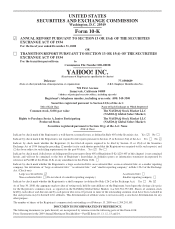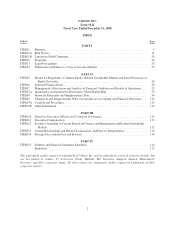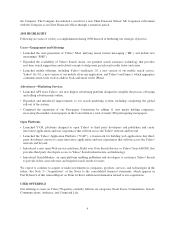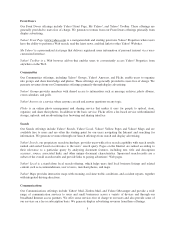Yahoo 2008 Annual Report Download - page 17
Download and view the complete annual report
Please find page 17 of the 2008 Yahoo annual report below. You can navigate through the pages in the report by either clicking on the pages listed below, or by using the keyword search tool below to find specific information within the annual report.Item 1A. Risk Factors
We face significant competition for users, advertisers, publishers and distributors, principally from Google,
Microsoft, and AOL.
We face significant competition from Google, Microsoft, and AOL, which each offer an integrated variety of
Internet products, advertising services, technologies, online services and content in a manner similar to Yahoo!.
Among other areas, we compete against these companies:
• to attract and retain users;
• to attract advertisers;
• to attract third-party Website publishers to participate in our Affiliate network; and
• to obtain agreements with software publishers, internet access providers, mobile carriers, device manufacturers
and others to promote or distribute our services to their users.
Google, Microsoft and AOL offer products and services that directly compete for users with our offerings,
including consumer e-mail, desktop search, local search, instant messaging, photos, maps, video sharing, content
channels, mobile applications, and shopping services.
We also compete with traditional media companies to attract advertising dollars, both domestically and
internationally. Currently many advertisers direct a portion, but only a portion, of their advertising budgets to
Internet advertising. In response, traditional media companies are increasingly expanding their content offerings
onto the Web and thus are competing not only to keep offline advertising dollars but also for a share of online
advertising dollars. We further compete for users, advertisers and developers with the wide variety of other
providers of online services, including social media and networking sites like Facebook and MySpace.com. In
recent years, social networks and social media sites have attracted an increased share of users’ online time.
Some of our existing competitors and possible additional entrants may have greater brand recognition for certain
products and services, more expertise in a particular segment of the market, and greater operational, strategic,
technological, financial, personnel, or other resources than we do. For example AOL, as a subsidiary of Time
Warner Inc., may have access to content from Time Warner’s movie, television, music, book, periodical, news,
sports, and other media holdings; access to a network of cable and other broadband users and delivery
technologies; and advertising offerings. In addition, Google and Microsoft have access to considerable financial
and technical resources with which to compete aggressively, including by funding future growth and expansion
and investing in acquisitions and research and development.
If our competitors are more successful than we are in developing compelling products or attracting and retaining
users, advertisers, publishers, developers, or distributors, our revenues and growth rates could decline. In
addition, competitors may consolidate with each other and new competitors may enter the market.
The majority of our revenues are derived from marketing services, and the reduction in spending by or loss of
current or potential advertisers would cause our revenues and operating results to decline.
For the year ended December 31, 2008, 88 percent of our total revenues came from marketing services. Our
ability to continue to retain and grow marketing services revenues depends upon:
• maintaining and growing our user base;
• maintaining and growing our popularity as an Internet destination site;
• attracting more advertisers to our user base;
• broadening our relationships with advertisers to small-and medium-sized businesses;
• the successful implementation and acceptance of our advertising exchange by advertisers, website publishers,
and online advertising networks;
11
























